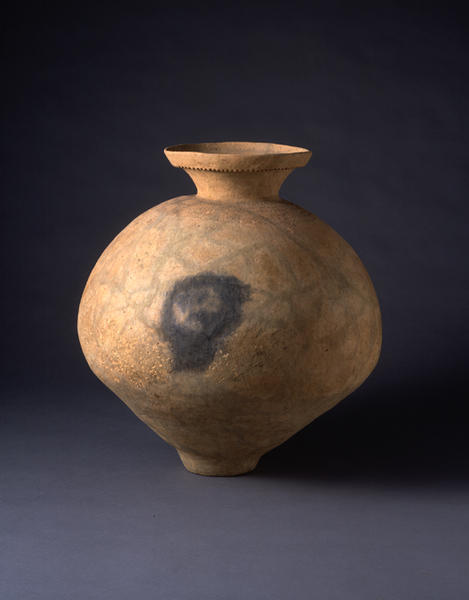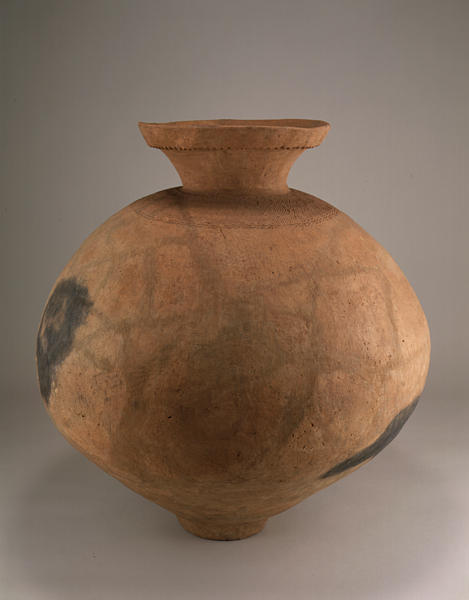土師器大壺
- 古墳時代
- 4c
- 素焼
- H-63.5 D-60
弥生式土器の系譜に属する赤褐色の素焼土器は、古墳時代にも引き続いて生産された。古墳時代から古代にかけて作られたこの種の土器を土師器と呼んでいる。一般に、丸底が多く装飾に乏しいが、古い土師器は小さな平底で、器表を櫛目文などで飾ることも多く、弥生式土器との区別は容易ではない。器形には実にさまざまな大きさ、種類があり、その用途も水や穀物の備蓄用のもの、煮炊きする料理用のもの、祭祀用のものなど多岐にわたっている。
この大壺は、大きく外に開いたいわゆる複合口縁に、豊かに張った胴、全体の大きさに比して極端に小さい平底をもつ。口縁下端部に歯状の刻みを施し肩部に網目状の櫛描文帯を巡らす。朱彩が施された痕跡は見当たらない。弥生時代後期から古墳時代初期にかけて作られたこのような大型壺は貯蔵用もしくは祭祀用具として用
いられたと考えられよう。出土地は不明であるが、大きく豊満な器形と胴に残る焦跡が非常に印象的な大壺である。
Catalogue Entry
The production of bisque-fired reddish brown earthenware, belonging to the Yayoi line stylistically, continued to be produced in the Kofun (Tumulus) period (300-710). This kind of earthenware produced in the Tumulus period through the Ancient period, is known as hajiki. This type of earthenware typically shows a round bottom and a paucity of ornamentation, yet, old hajiki may feature small flat bottoms often decorated with comb tooth patterns on the surface. These features of construction and in ornamentation make it difficult to discern old hajiki from Yayoi earthenware. The shape and size of hajiki is truly diverse, reflecting its versatile usage, including storing water and grains, cooking, and ritual and ceremonial use.
This large jar features a mouth that widely blooms outward, a fully rotund body, and a small flat bottom disproportional for the size of the jar. Tooth-like notches are cut at the lower edge of the mouth, and a belt of a combed mesh pattern surrounds the jar at its shoulder. No trace of vermilion is observed. It may be inferred that large jars of this sort produced from the late Yayoi period through the early Tumulus period were most likely used for storing food or religious rites. Glamorous silhouettes and scorching on the body is very attractive. The site of excavation of this piece is unknown.

